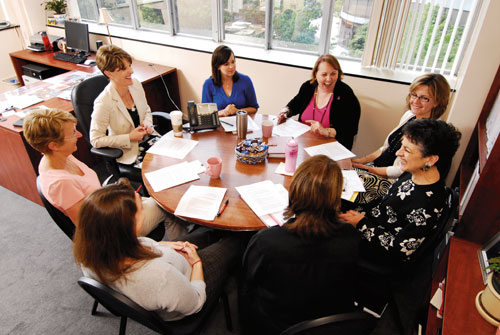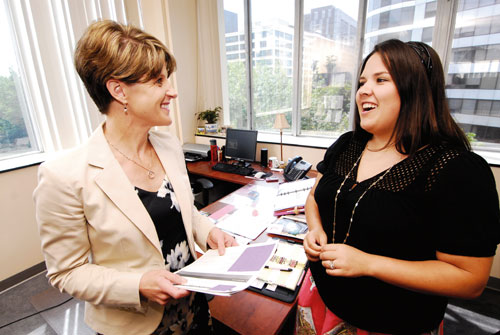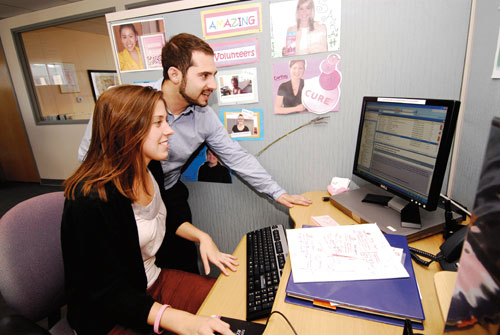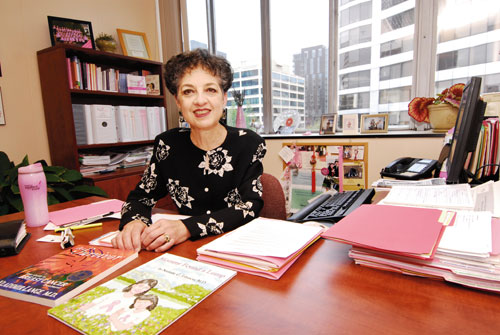 In an organization with the simple, yet profound mission “to save lives,” it’s not surprising to see raw emotion cracking the surface of cool professionalism during meetings, phone calls and public events.
In an organization with the simple, yet profound mission “to save lives,” it’s not surprising to see raw emotion cracking the surface of cool professionalism during meetings, phone calls and public events.
No. 1 Best Large Nonprofit: Susan G. Komen for the Cure/Oregon and SW Washington
STORY BY LUCY BURNINGHAM // PHOTOS BY ANTHONY PIDGEON
 |
Executive director Christine McDonald (top left) and her staff create a workplace where employees genuinely care about each other. |
In an organization with the simple, yet profound mission “to save lives,” it’s not surprising to see raw emotion cracking the surface of cool professionalism during meetings, phone calls and public events.
After all, the staff at the Oregon and Southwest Washington affiliate of Susan G. Komen for the Cure participates in a large-scale human struggle; they work with some of the thousands of women diagnosed with breast cancer fighting to stay alive. Sometimes, those battles end tragically.
“You come together with these tragedies,” explains executive director Christine McDonald. “We know we have a job to do and that we serve a serious mission.”
The group’s mission stems from a larger dream: a world without breast cancer. In the meantime, the Portland office, as an extension of the 590-employee national Komen organization, works to raise awareness about the disease to help prevent deaths, support survivors and fund scientific research.
That work is particularly relevant in the Pacific Northwest, the area with the highest rate of breast cancer in the country.
 |
Executive assistant Devon Downeysmith (right) is inspired by boss Christine McDonald. |
Last week, Toni Mountain, the office’s survivor programs manager, announced during a staff meeting that she’d lost one of her younger survivors, a 35-year-old woman with a young son.
“I’m the biggest crier,” says Mountain, a 31-year breast cancer survivor who’s dedicated her career to helping the one in eight women who will be diagnosed with the disease. She says that the Komen office is filled with employees who genuinely care about each other and respect each other’s talents.
But most importantly, she says, the workplace helps her continue this important work, a sentiment echoed by most staff members, no matter what their personal connection to the disease.
In fact, within offices peppered by pink folders, calendars, pamphlets, papers and highlighter pens (to match the famous pink ribbons, which represent breast cancer awareness), it’s difficult to get any one of the 13-person local staff to deviate from talk about the mission. They make everything else, including raises, flextime and paid leave seem like the inedible plastic flowers on an already frosted cake.
Komen’s work requires funding, most of which comes from the annual Portland Race for the Cure, which attracts 50,000 participants, 1,200 volunteers and thousands of supporters, making it the third-largest Komen race in the world.
 |
Race intern Teryll Evans and event coordinator Ian Gadburry collaborate. |
Participants pay a $100 race fee, $77 of which is considered a donation to the organization to cover the average cost of one mammogram. But participants are encouraged to make larger donations and do additional fundraising.
Three-quarters of all funds raised by the local affiliate stay in Oregon and the three counties in southwestern Washington served by the group. Remaining funds go to the national organization, which subsidizes breast cancer research.
Kyle Camberg, corporate relations manager, who works almost entirely on the race, says the high-profile event gives the public a false sense of security.
“People say, ‘You have so many people at the race, it must be perfect,’” he says. “But there’s so much more we could be doing.”
Even so, Camberg says it’s difficult not to get caught up in the emotion of the big day, between the survivors wearing pink shirts and caps (3,000 of them ran last year) and participants wearing “in memory of” or “in support of” signs covered with handwritten names.
 |
The iconic pink breast-cancer color surrounds survivor programs manager Toni Mountain. |
“It gets really emotional,” he says. “I see young men there with their children filling out ‘in memory of’ signs for the kids’ mom. As a new dad, it’s hard for me to see.”
Christine McDonald took the organization’s helm five years ago and during her tenure the local Komen affiliate has doubled its revenue and its staff, which employees say has created an important sense of stability that many nonprofits lack.
Devon Downeysmith, McDonald’s executive assistant, says she takes inspiration from her boss, who once sent her flowers after she planned her first board meeting and constantly tells her she can be anything.
“She’s got a knack for looking at people and seeing what they have to offer and making sure they feel valued,” Downeysmith says.
McDonald prefers to promote from within: Three current staff members who formerly worked as administrative assistants now hold other positions.
But here, career advancement doesn’t seem like an ultimate goal. In fact, the staff is constantly working toward a world where their jobs will be obsolete thanks to a cure for breast cancer. In the meantime, they’ll keep wearing pink.

